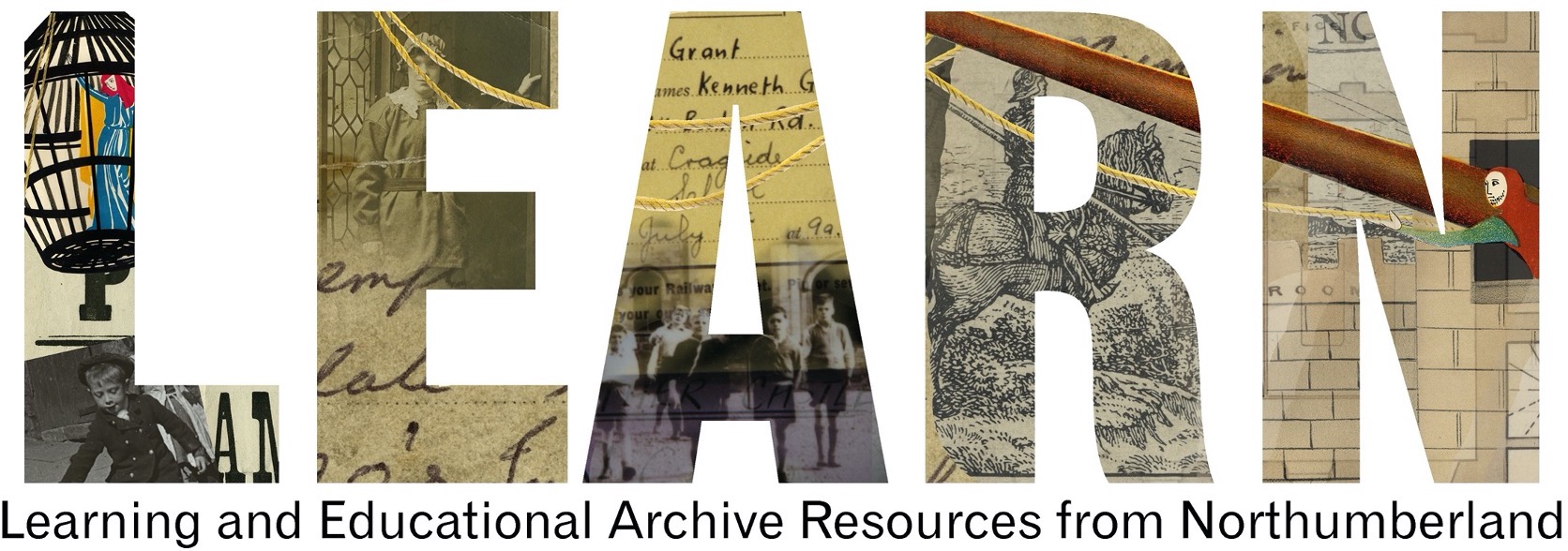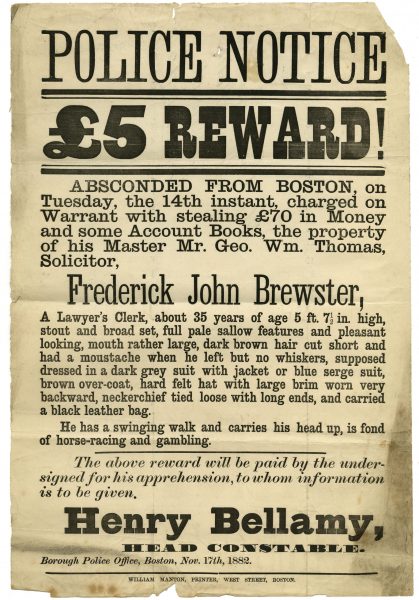Police wanted poster for Frederick John Brewster, 1882
Police Wanted Poster for Frederick John Brewster, 1882
Reference: BA/C/PO/15/11/35
Suggested age groups: KS2, KS3, KS4, lifelong learners
Subject areas: History, Literacy, Maths, Art
CONTEXT
In the late nineteenth and early twentieth centuries police forces sent out posters like this to other police stations across the country. They were designed to inform and to alert the local police about criminals or runaways that might come into their area.
These posters were collected by Berwick Borough Police, who were probably on the lookout for English criminals trying to get to Scotland and Scottish criminals trying to escape to England.
The posters often have a detailed description and image of the wanted person, the stolen goods or the crime being investigated. Later posters included photographs.
Along with the posters a number of postcards confirming that a crime has been solved are in this collection. Some of the posters were written on by the Berwick Police to show that they had carried out a search for the person on the poster.
An article in the Lynn Advertiser (25 November 1882) sheds a bit more light on the case. Frederick John Brewster worked for George William Thomas who was a solicitor and Town Clerk in Boston, Lincolnshire. According to the newspaper, George Thomas claimed that he had been ill and left Frederick Brewster in charge of the office. Frederick took advantage of this situation to steal “books, securities and valuable papers of all kinds” and to disappear. The newspaper states that Brewster left Boston by train at 8am in the morning, but that trains at that time ran in four different directions so finding him was proving difficult.
Once Brewster’s departure had been discovered, it became obvious that lots of money that came into the office to pay for mortgages and deposits had not been passed on. This meant that lots of people in the town thought that they owned land or buildings that they had paid money for, but which they had no legal claim for. It is implied that Brewster took the money.
The Lynn Advertiser also reported that the theft and fraud forced Thomas to close his business. He applied to Boston County Court on 17th November to liquidate his affairs; he went bankrupt.
We haven’t been able to find any evidence that Brewster was ever found by the police. However, the Boston Guardian reported on the trail of George Thomas in July 1883 for fraud. He was found guilty and sentenced to 18 months in prison with hard labour.
John Frederick Brewster was accused of stealing £70. This would be worth about £8,500 today. The £5 reward for his capture would be worth about £600.
ACTIVITIES
ACTIVITY 1
Background
In the late nineteenth and early twentieth centuries police forces sent out posters like this to other police stations across the country. They were designed to inform and to alert the local police about criminals or runaways that might come into their area.
SEE
See: What did Frederick John Brewster steal?
See: Who did Frederick John Brewster steal from?
See: Where did Frederick John Brewster abscond from?
THINK
Think: Why did wanted posters need to include a description of the person?
Think: Why doesn’t the wanted poster have a photograph of Frederick John Brewster?
Think: Why did police forces share wanted posters?
Think: How might Frederick John Brewster travel from Boston to Berwick? Look on a map and find how far apart Berwick and Boston are. Which route might he have travelled by?
Think: Where else might Frederick John Brewster have travelled to?
Think: What was the most common type of crime in the 1880s? Compare this to the most common type of crime today.
DO
Do: Using the description draw a portrait of Frederick John Brewster to be included on the wanted poster.
Do: Using the information from the Lynn Advertiser article, write a newspaper article about John Edward Brewster and his crimes.
Do: Research Victorian hats and design your own hat.
Do: Craft your Victorian hat.
Do: Take a photograph of yourself in your Victorian hat and make a wanted poster for yourself.
Do: How is Frederick John Brewster’s walk described? Can you try to walk this way? How would you describe the way that you walk?
Resources
ACTIVITY 2
Background
After 1971 the UK moved to a new decimalisation system and brought currency into line with the metric systems used in Europe, which are based on a system of factors of 10.
SEE
See: How much money did Frederick John Brewster steal?
See: How much was the reward for information on or for capturing Frederick John Brewster?
THINK
Think: What units of currency were used in Britain during the 1800s?
Think: When did Britain change to using the decimal currency system that we currently use?
DO
Do: Can you work out what the equivalent of the stolen money and the reward would be today giving consideration to inflation?
Do: Do cash rewards actually help catch criminals? Research how effective this is. Can you use percentages and charts to show how often people claimed cash rewards for catching criminals during the Victorian period and how successfully this is used today?
Resources
OTHER ONLINE RESOURCES
Blog post about the wanted posters:
https://northumberlandarchives.com/2019/02/04/twixt-thistle-and-rose-4/
Bank of England inflation calculator (works out the worth of money in the past): https://www.bankofengland.co.uk/monetary-policy/inflation/inflationcalculator
Victorian Crime and Punishment:
http://vcp.e2bn.org/


